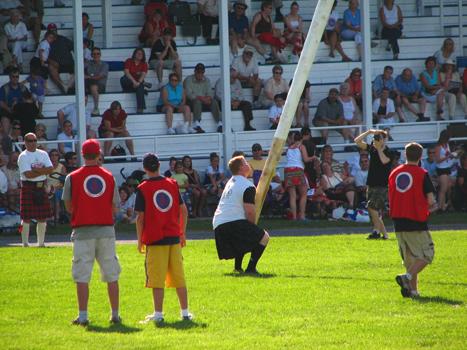Timber! Scottish Sport of Caber Tossing Tests Contestants’ Log-Lifting Strength
July 31, 2011
One of the major differences between Americans and Scots is their view of the “wooden log.” Most Americans see wooden logs as material for making paper, holding telephone wires and building models of Abraham Lincoln’s cabin. But where Americans see a heavy, 20 foot long log (that someone really needs to move), the Scottish see a heavy 20 foot long log that they can move (in a very excessive, showy way).

For Scots, moving large heavy logs equals the unique Scottish sport of caber tossing. In the caber toss, a person lifts a large tree trunk and tries to throw the log into a specific position. The sport is thought to have originated from Scottish foresters who constantly had to clear tree trunks out of the way. Instead of using a truck, the foresters would lift the trunk themselves, eventually making a contest out of the throws.
There tend to be slight variations in the rules depending on the location of the game. However, for the most part, there are a few standards that games follow. The caber, the name of the log, must be regulation size, 18 feet nine inches and a minimum of 150 pounds. The logs are measured and weighed at the beginning of the competition, and then weighed again after each round to ensure that the log hasn’t become lighter due to the wood drying. If the log has lost weight, the judges will soak it in a special liquid that is designed not to dry out.
The competitor lifts the caber from the base, and using either a stationary or running start, attempts to throw the log so that it completes a half revolution. A perfect throw has the top of the caber land closest to the thrower in a straight line. If a contestant does not make a perfect throw, their throw is judged on the angle. Try imagining the log as the hand of a clock. The closer to midnight, the better the score. For example if a person tosses a caber and it lands slightly to his right, it is said to land at “11:00.” This would beat out a contestant whose log landed at a nearly right angle, which would be judged as “9:00.”
Despite the nationalist traditions behind the sport, Fordham students had difficulty appreciating the game.
“It seems like a world’s strongest man event,” Raymond Tam, Fordham College at Lincoln Center (FCLC) ’11, said. “It seems like something that people just use to prove how strong they are.”
Without a proper level of appreciation or experience, most students proved to be somewhat hesitant to try the sport, citing the extreme danger of throwing logs high above one’s head.
“I would never play it,” Tam said. “It seems very dangerous. You could easily seriously hurt your back.”
Even without the support of the Fordham community, caber tossing still retains its place as a sport. After all, it involves impressive feats of athletic prowess, a large stick, and potential for unimaginable pain and death, all factors that have helped other sports grip the national consciousness. Perhaps with a little tweaking and some good marketing, the caber toss can become as big as professional ping pong. One can only hope.












